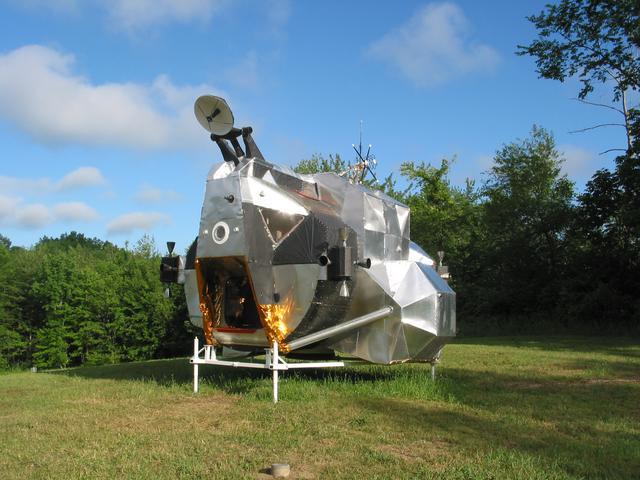Omnibus Filing

Work by Steven Brower.
“Omnibus filing” is a legal term used to describe the collection of a number of disparate and perhaps unrelated ideas into a single patent application. In the context of creative collaboration, the intellectual framework of the exhibition Omnibus Filing contains: A) a mechanism to formalize ideas at the edge of imagination and reality; B) a critical dialectic for cross-disciplinary work on the basis on invention; and C) a real-world metric of the feasibility of creative concepts. The exhibition’s title references this intellectual space in metaphor and reality, through a cross-disciplinary practice that blurs lines between the two. When scientists, engineers, artists, and researchers collaborate, hypotheticals become realities, daydreams become tangible and imagination’s optimism infects the culture of the lab.
This exhibition’s premise began with the idea that artists are everyday innovators, whether they invent a new way to use a material, or create machines and processes to realize visions. Acknowledging that both the laboratory and the innovation process could vastly benefit from interdisciplinarity’s creative disruption, Assistant Professor James Sham and Dr. Brian Korgel devised a program called Rapid Design Pivot, which embeds artists into laboratory environments to conduct creative projects alongside and in collaboration with UT researchers. The artists in this exhibition, Daniel Bozhkov, Patrick Killoran, Steven Brower, and James Sham have worked in various laboratories from 2016-2017 with the mandate to collaborate, cross-pollinate, and catalyze innovation with UT researchers and scientists. By training the artists in the basic skills required to function semi-independently within the laboratory environment, the effects and outcomes have been widespread and varied in nature. Some projects materialize as contemporary art installations while others manifest as research papers, prototypes and demonstrations of emerging technology. Releasing artists as a radicalizing presence in the laboratory, research trajectories pivot drastically.
In the innovation process, finding the right application of new materials and technologies is often a long, expensive, and cumbersome process. Even after achieving amazing and proven results in laboratory, it is incredibly difficult to bring new technologies and research in the world. The costly, timely, and problematic process of discovering applications for new materials often nullifies their impact. This exhibition began as a way to catalyze innovation by bringing artists—specialists in using materials in unexpected ways—into the laboratory environment to create projects with experimental new innovations. To punctuate these creative collaborations, each project has been submitted by the collaborative teams to The University of Texas Office of Technology Commercialization for patent consideration, an arena in which odd ideas accelerate into the world.
Omnibus Filing showcases a new approach to innovation that combines arts, sciences, and engineering in a fully collaborative process. Treating The University of Texas at Austin as an innovation hub, artists have worked with researchers, scientists, engineers and emerging companies to import some radicality and creative disruption into the laboratory environment.
This exhibition is organized by James Sham and Brian A. Korgel.
Additional exhibition support comes from the College of Fine Arts and the Office of the President at The University of Texas at Austin, and the Skolkovo Institute of Science and Technology.
Bios
Self-described as a “post-studio artist with a studio practice,” Daniel Bozhkov’s projects span a various media, from performance to fresco, cornfields, and DNA-modified bacterial yogurt. Bozhkov’s exhibition record includes shows at the Queens Museum, New York, the 2010 Liverpool Biennial, the 6th Mercosul Biennial in Porto Alegre, Brazil, and the 9th Istanbul Biennale. Bozhkov is also the recipient of many honors including the 2007 Chuck Close Rome Prize of the American Academy in Rome.
Steven Brower’s diverse projects involve fabricating various aerospace artifacts including space suits, planetary landers, and a lunar excursion module permanently installed at the Seattle Museum of Space Flight. Brower’s multifaceted and expansive work appears in educational contexts, film and television productions, galleries and museums. BPL, a fictitious aerospace company founded by Brower for art purposes, ultimately became a legitimate business entity, having succeeded in multiple cross-disciplinary research efforts with scientists and government entities.
Patrick Killoran’s work addresses consumerism’s effect on conceptions of public space. Much of his work explores the inevitable contradictions that arise with the terms “public space” and “public art,” in the realm of the products and behaviors of consumer culture. Killoran’s distinguished exhibition history includes numerous international exhibitions, including Everyday, the 1998 Biennial of Sydney, Wanås 2000 in Sweden, and The Part of the Story at the With de Witte in Rotterdam, Netherlands. Killoran lives and works in New York City.
James Sham’s cross-disciplinary practice focuses on interfacing technologies and material processes from a variety of disciplines within a contemporary art practice. Sham’s work involves multiple areas of focus including pigment extraction and using eye-tracking technology to study interpretation in deaf culture. His work has been exhibited in many international venues including White Box Gallery, New York City; European Cable Network Broadcast, Germany and France; the Ellensburg Film Festival, Seattle; and the Asian Arts Initiative in Philadelphia, among others.




